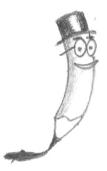 |
 |
|
"About Dolphins"Home » Animal Pencil Sketches » Dolphin Drawings » About Dolphins Dolphins are aquatic mammals which are closely related to whales and porpoises. There are almost forty species of dolphin in seventeen genera. They vary in size from 1.2 metres (4 ft) and 40 kilograms (88 lb) (Maui's Dolphin), up to 9.5 m (30 ft) and ten tonnes (the Orca or Killer Whale). They are found worldwide, mostly in the shallower seas of the continental shelves, and are carnivores, mostly eating fish and squid. The family Delphinidae is the largest in the Cetacea, and relatively recent: dolphins evolved about ten million years ago, during the Miocene. Dolphins are considered to be amongst the most intelligent of animals and their often friendly appearance and seemingly playful attitude have made them popular in human culture. Dolphins have a streamlined fusiform body, adapted for fast swimming. The basic colouration patterns are shades of grey with a light underside and a distinct dark cape on the back. It is often combined with lines and patches of different hue and contrast. The head contains the melon, a round organ used for echolocation. In many species, the jaws are elongated, forming a distinct beak; for some species like the Bottlenose, there is a curved mouth which looks like a fixed smile. Teeth can be very numerous (up to two hundred and fifty) in several species. The dolphin brain is large and has a highly structured cortex, which often is referred to in discussions about their advanced intelligence. Unlike most mammals, dolphins do not have hair, but they are born with a few hairs around the tip of their rostrum which they lose after some time, in some cases even before they are born. The only exception to this is the Boto river dolphin, which does have some small hairs on the rostrum. There are more about dolphins... Dolphins are often regarded as one of Earth's most intelligent animals, though it is hard to say just how intelligent dolphins are, as comparisons of species' relative intelligence are complicated by differences in sensory apparatus, response modes, and nature of cognition. Furthermore, the difficulty and expense of doing experimental work with large aquatics means that some tests which could meaningfully be done still have not been carried out, or have been carried out with inadequate sample size and methodology. Dolphin behaviour has been studied extensively by humans however, both in captivity and in the wild. Okay... that's all about dolphins at the moment. Now, let's start your dolphin drawings, step by step...

Return from About Dolphins to Dolphin Drawings page. |
Follow Us
What Pencil Drawing Topics Are You Looking For Today?
Best Deals
Let's Share & Comment!
Your Drawing Space
|
|
|
Enjoy This Site?
Then why not use the button below, to add us to your favorite bookmarking service? |
||
|
Homepage | How
To Start Drawing | Drawing Materials | Drawing
Pencil Set | Angel Drawings | Animal
Drawings | Flower
Drawings | Rose
Drawings | People
Drawings | Cartoon
Drawings | Manga
Drawings | Art
School | Graphic Design
Schools | Your
Drawing Space | Articles
| Art
Gallery Links | Contact
Me | About
Me | Search
Your Topics | For
Webmasters | Exchange Link | Testimonials | Sitemap
| Privacy Policy | Disclaimer

Return to top |
||
|
Copyright© Pencil Drawings 2007-2012. Get High Ranking On Major Search Engines | ||

